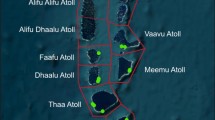Abstract
Muthupet mangrove ecosystem (10° 25′ N and 79° 30′ E) is located at the southern end of the Cauvery delta on the east coast of India. The swamp is characterized by the presence of only 4 species of exclusive mangroves namelyAvicennia marina, Excoecaria agallocha, Aegiceras corniculatum andAcanthus ilicifolius.
Community structure analysis carried out at four randomly selected quadrats showed that the relative density, relative dominance, relative frequency and importance value ofA. marina was relatively higher than for the other three species. Hence, Muthupet mangrove ecosystem is characterized by the mono-specific dominance ofA. marina. Earlier palynological studies indicate that species likeRhizophora were present in this swamp some 200 years ago. It is believed that the past management practices together with the present poor scientific policy of the decision makers and harsh environment conditions may be considered as a few factors responsible for the disappearance ofRhizophora from this mangrove swamp.
Similar content being viewed by others
References
Ahmed, S., 1937. Working plan for the Tanjore Forest Division Revenue Department, District Board of Tanjore, 82 pp.
Blasco, F., 1975. Mangroves of India. Inst. Fr. Pondicherry, Trav. Sect. Sci. Tech., Vol. 14. 180 pp.
Burbridge, P. R., 1984. Management and Planning of Mangrove Resources of India. Proc. As. Symp. Mangr. Env. — Res. Manag., 27–42.
Chengappa, D., 1918. Working Plan for the Tanjore Forest Division. Revenue Department, District Board of Tanjore, 78 pp.
Cintron, G. & Y. S. Novelli, 1984. Methods for studying mangrove structure. In: Snedaker, S. C. & Snedaker J. G. (eds). The Mangrove Ecosystem: Research Methods. Monographs on Oceanographic Methodology. UNESCO, Paris, 91–113.
Gazette, 1937. Government of the Presidency of Madras, Madras, 318 pp.
Gamble, G. S. & C. E. S. Fischer, 1957. Flora of the Presidency of Madras Vol. I–III, Government of India, Calcutta, 1388 pp.
Prain, D., 1905. Flora of the Sunderbans. Rec. Bot. Sur. India 2: 237–370.
Saenger, P., E. J. Hegerl & J. D. S. Davis, 1983. Global status of mangrove ecosystems. Commission of Ecology paper No. 3 IUCN, Gland, 38 pp.
Sidhu, S. S., 1963. Studies on the mangroves of India. I-East Godavari region. Indian Forester 89: 337–351.
Tissot, C., 1987. Recent evolution of mangrove vegetation in the Cauvery Delta: A palynological study. J. mar. biol. Ass. India 29: 16–22.
Untawale, A. G., 1984. Present status of mangrove along the west coast of India. Proc. As. Symp. Mangr. Env. — Res. Manag: 57–74.
Untawale, A. G., 1987. Conservation of Indian mangroves — A national perspective. In: Rao, T. S. S. (ed.), Contribution in Marine Sciences. National Institute of Oceanography Goa: 85–104.
Venkatesan, K. R., 1966. The mangroves of Madras state. Indian Forester 92: 27–34.
Author information
Authors and Affiliations
Rights and permissions
About this article
Cite this article
Azariah, J., Selvam, V. & Gunasekaran, S. Impact of past management practices on the present status of the Muthupet mangrove ecosystem. Hydrobiologia 247, 253–259 (1992). https://doi.org/10.1007/BF00008226
Issue Date:
DOI: https://doi.org/10.1007/BF00008226




